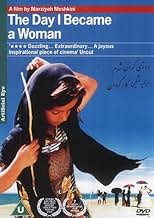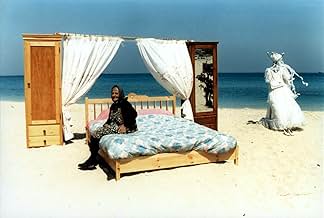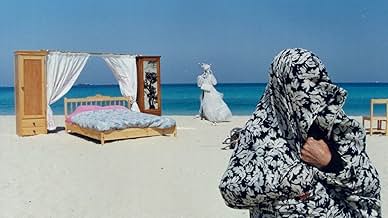IMDb RATING
7.3/10
2.1K
YOUR RATING
Three linked stories show women at life's crossroads: a girl's 9th birthday, a cycling race, and an elderly woman's dream of buying long-desired items.Three linked stories show women at life's crossroads: a girl's 9th birthday, a cycling race, and an elderly woman's dream of buying long-desired items.Three linked stories show women at life's crossroads: a girl's 9th birthday, a cycling race, and an elderly woman's dream of buying long-desired items.
- Director
- Writers
- Stars
- Awards
- 10 wins & 5 nominations total
- Director
- Writers
- All cast & crew
- Production, box office & more at IMDbPro
Featured reviews
I saw this gem of a film a few months ago and it has lived with me ever since. There are lots of great things to talk about but I will only mention a few. I liked the striking images of the sea and the shore and the manner in which they are imbued with great meaning. The sea - which represents adventure, sensuality, fluidity, freedom and sex - is a constant motif throughout the film and is a joy to look at. I also liked the structure - reminiscent of Hemingway's short stories - where characters from one story seem to reappear in others.
But though connected through theme and also through the plot, the individual films retain a great level of distinctiveness. For instance, the second film remains unresolved at the end and the discussion of the two fellow riders in the third movie only have the effect of heightening that suspense. On the other hand, the third film has the effect of satisfactorily and unexpectedly wrapping up the first film: whereas the girl in the first film was denied the chance to enjoy the sea (and everything it represents), the old woman in the third film takes her revenge by completely inverting tradition. The image of the old woman and those motifs of domesticity being carried away on the sea is unusual but also funny. In putting not only herself but also her whole house on the sea, the old woman has inverted tradition and has the ultimate revenge.
But though connected through theme and also through the plot, the individual films retain a great level of distinctiveness. For instance, the second film remains unresolved at the end and the discussion of the two fellow riders in the third movie only have the effect of heightening that suspense. On the other hand, the third film has the effect of satisfactorily and unexpectedly wrapping up the first film: whereas the girl in the first film was denied the chance to enjoy the sea (and everything it represents), the old woman in the third film takes her revenge by completely inverting tradition. The image of the old woman and those motifs of domesticity being carried away on the sea is unusual but also funny. In putting not only herself but also her whole house on the sea, the old woman has inverted tradition and has the ultimate revenge.
10jakub66
Having followed Iranian cinema for a while I didn't think I was in for a surprise but Meshkini (director) managed to blow me away with the minimalist approach to depicting the fundamental issues of Iranian society. The elegance, minimalism and eloquence of this picture manage to depict the role of a woman in Iran with painful clarity.
"Roozi khe zan shodam" is an essential and defining piece of cinema.
"Roozi khe zan shodam" is an essential and defining piece of cinema.
Absolutely stunning. On the surface it's a triptych of short stories showing a girl, young wife, and old woman in Iran, but it plays as allegory, and the way it's executed by director Marzieh Meshkini is masterful. She shows great restraint and precision in everything she does, delivering a message with enough ambiguity to make the viewer ponder, and yet clearly showing the constraints of being a woman in a male-dominated society. The middle story in particular was as poetic and profound an expression of the patriarchy as I've ever seen; it was simply breathtaking. This is a film that should be far better known and seen; seek it out.
10strambi
Nothing against the American industry, but if you are looking for a Hollywood type of movie try something else. Yes, there is plenty of beauty and fantasy, but not in the American fashion. Here the stories and people and places are very simple (and very deep). Yet, the fantasy is so real that you can very easily transpose it to your own life, regardless if you came from Middle East, Japan or Americas. Well, as long as you have some brains and some subtlety. After I saw this movie I spent weeks thinking about it,and I learned so much. Every single detail of the story, camera work and sound has a meaning.
I read a magazine review critic complaining the movie was boring, specially the first story, in which the girl (according to that critic review) was a very bad actress, concerned about not playing that day, but not showing emotions for what her life was going to be. Does a nine year old girl understand what is "becoming a woman"? Of course not, her understanding was limited to that moment when she was being forbidden to play with her best friend. This is exactly what made the story so universal, I could remember myself (raised on an environment with freedom for women) waiting for the permissions of my mother, desperately waiting for the time of the adults. And inside the critical context of the movie, her lack of understanding of what her life was going to become was also very important. Inside that real life drama, people take care of their everyday lives, and go on. Oh, and so many other meanings and symbols just in this first story. The wind and water (also present in the other two stories), the plastic fish by which she exchanges her chaddor, her little time passing away and she unable to use it and still waiting, her availability, the lollipop teasing across the bar separating her from her boy friend (the *given* pleasure the only control left to her), her mother coming to pick her up, etc.
The other two stories are as good and universal. Even if you live inside a women's lib society, even if you are a man. This movie is a work of art. So, it demands sensibility for understanding it. If you are looking for fast food entertainment, forget about it.
I read a magazine review critic complaining the movie was boring, specially the first story, in which the girl (according to that critic review) was a very bad actress, concerned about not playing that day, but not showing emotions for what her life was going to be. Does a nine year old girl understand what is "becoming a woman"? Of course not, her understanding was limited to that moment when she was being forbidden to play with her best friend. This is exactly what made the story so universal, I could remember myself (raised on an environment with freedom for women) waiting for the permissions of my mother, desperately waiting for the time of the adults. And inside the critical context of the movie, her lack of understanding of what her life was going to become was also very important. Inside that real life drama, people take care of their everyday lives, and go on. Oh, and so many other meanings and symbols just in this first story. The wind and water (also present in the other two stories), the plastic fish by which she exchanges her chaddor, her little time passing away and she unable to use it and still waiting, her availability, the lollipop teasing across the bar separating her from her boy friend (the *given* pleasure the only control left to her), her mother coming to pick her up, etc.
The other two stories are as good and universal. Even if you live inside a women's lib society, even if you are a man. This movie is a work of art. So, it demands sensibility for understanding it. If you are looking for fast food entertainment, forget about it.
I saw "Roozi khe zan shodam" ("The Day I Became a Woman") a few days ago during the Memorial Day holiday. It was a good film with strong, subtle acting and quite interesting camera shots.
In a nutshell, the film is about women in contemporary Iran. It depicts compelling accounts about a girl who has just turned nine and is now therefore considered to be a woman and expected to leave childhood play behind; a woman's bicycle race and the strong objection a husband has to his wife's participation; and an elderly woman who has in earlier life deferred her desires to buy consumer goods and finally has the opportunity to realize her spending dreams.
Without having lived in or even visited Iran, I can't judge the realism of "Roozi khe zan shodam". The camera offers us an innocent, child-like eye, just observing these characters and leaving us to draw our own conclusions. I particularly enjoyed the cinematography of the mass of women cyclists, all clad in black practically head to foot, pedaling away almost entirely in silence except for the rhythmic pedaling noises; and the parallel shots focusing on the legs of the galloping horses, carrying the complaining husband and his cohorts. The pedaling wife Ahoo (Shabnam Tolui) never speaks a word, but her focused and desperate efforts indicate her quest for increased independence. I also enjoyed following the activities of 9-year-old Hava (Fatemeh Cherag Akhar).
I would see "Roozi khe zan shodam" again for its cinematography and the unique (at least for Western audiences) life experiences depicted. It's by no means Hollywood fare or even overtly feminist, but allows the viewer to settle in for a bit of (realistic or stylized?) local color and look at perspectives there of women in three different stages in their lives.
In a nutshell, the film is about women in contemporary Iran. It depicts compelling accounts about a girl who has just turned nine and is now therefore considered to be a woman and expected to leave childhood play behind; a woman's bicycle race and the strong objection a husband has to his wife's participation; and an elderly woman who has in earlier life deferred her desires to buy consumer goods and finally has the opportunity to realize her spending dreams.
Without having lived in or even visited Iran, I can't judge the realism of "Roozi khe zan shodam". The camera offers us an innocent, child-like eye, just observing these characters and leaving us to draw our own conclusions. I particularly enjoyed the cinematography of the mass of women cyclists, all clad in black practically head to foot, pedaling away almost entirely in silence except for the rhythmic pedaling noises; and the parallel shots focusing on the legs of the galloping horses, carrying the complaining husband and his cohorts. The pedaling wife Ahoo (Shabnam Tolui) never speaks a word, but her focused and desperate efforts indicate her quest for increased independence. I also enjoyed following the activities of 9-year-old Hava (Fatemeh Cherag Akhar).
I would see "Roozi khe zan shodam" again for its cinematography and the unique (at least for Western audiences) life experiences depicted. It's by no means Hollywood fare or even overtly feminist, but allows the viewer to settle in for a bit of (realistic or stylized?) local color and look at perspectives there of women in three different stages in their lives.
Did you know
- TriviaMarzieh Makhmalbaf's directorial film debut.
- GoofsIn the first sequence, the lollipop that Hava and Hassan pass between them grows and shrinks in size without regard to the passage of time.
- Quotes
Grandmother: Will you promise to be back by noon?
Hava: I promise!
Grandmother: God won't forgive you if you lie. Don't be late.
- ConnectionsFeatured in Women Make Film: A New Road Movie Through Cinema (2018)
Details
- Release date
- Country of origin
- Official sites
- Language
- Also known as
- The Day I Became a Woman
- Filming locations
- Kish Island, Iran(location)
- Production companies
- See more company credits at IMDbPro
Box office
- Budget
- $180,000 (estimated)
- Gross US & Canada
- $149,971
- Opening weekend US & Canada
- $48,255
- Apr 8, 2001
- Gross worldwide
- $149,971
Contribute to this page
Suggest an edit or add missing content

Top Gap
By what name was Le jour où je suis devenue femme (2000) officially released in India in English?
Answer


















